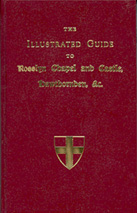The Illustrated Guide to Rosslyn Chapel, Hawthornden &c.
 Rosslyn Chapel – What is it? – A Pagan place of worship?, Masonic building? or a Jewish Temple?
Rosslyn Chapel – What is it? – A Pagan place of worship?, Masonic building? or a Jewish Temple?- Why was it built, by whom and for what purpose?
- Who is buried in the vaults below the chapel?
- Green Men – What are they? – Animal, vegetable or mineral?
- Is the death mask of Robert the Bruce in the retro-choir?
- Are there carving of cactus in the chapel and if so does this prove that Scotsmen discovered America before Christopher Columbus?
- Was the chapel deliberately left unfinished?
- Who was the last Grand Master to be buried at the chapel?
All these questions and more are answered in this volume which provides immense detail about the chapel and the surrounding area.
This book, long out of print, is a treasure chest of information written by a Priest who had intimate knowledge of the chapel. Whether you use this Guide when visiting the chapel or simply read it to learn more about this most interesting edifice it is a must for all those interested in the chapel.
Edited by Brother Robert L. D. Cooper, Curator, of the Grand Lodge of Scotland Museum and Library.
It is possible to order the book – download Order Form (PDF)
If you do not have Adobe Acrobat Reader (necessary to open and read PDF files) you can download it free from: http://www.adobe.com
This book has been now been published. To read a review of the book please see below.
Book Review
 There has been so much published in the last 20 years or so that it is extremely difficult to know what is nonsense and what is good solid research. This book: An Illustrated Guide to Rosslyn Chapel was the official guide book sold at the Chapel and elsewhere from 1892. The book has long since ceased to be used and was replaced by more ‘speculative’ publications which emphasised the mythological rather than the Christian.
There has been so much published in the last 20 years or so that it is extremely difficult to know what is nonsense and what is good solid research. This book: An Illustrated Guide to Rosslyn Chapel was the official guide book sold at the Chapel and elsewhere from 1892. The book has long since ceased to be used and was replaced by more ‘speculative’ publications which emphasised the mythological rather than the Christian.
This new edition publication of the original guide book to Rosslyn Chapel means that, for the first time in recent memory, people can now compare what was first published about the chapel and what is available now. That comparison reveals some extremely interesting differences between what was described one hundred years ago and how Rosslyn Chapel is described today.
Of even more interest is the interpretation of the Chapel. The reader will be able to, for example, compare what a particular stone carving meant to people over 100 years ago and what the same stone carving has been re-interpreted by present day authors.
Anyone interested in the history of Rosslyn Chapel, Freemasonry (especially Scottish Freemasonry), the Sinclair (or St Clair) family and the Knights Templar really needs to have this book on their bookshelf.